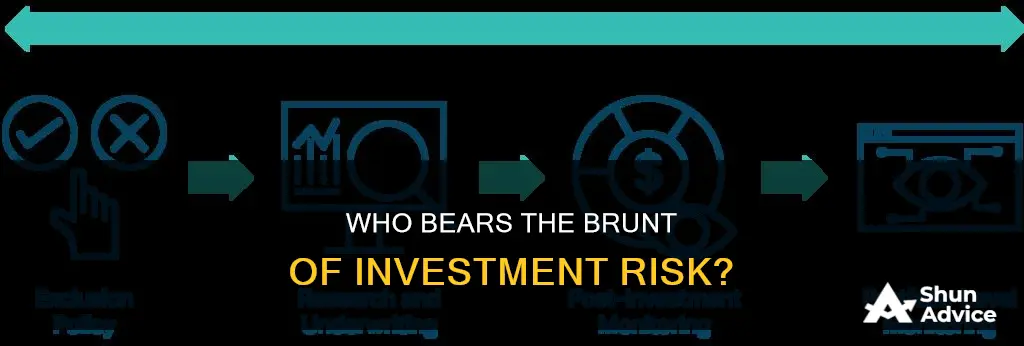
When it comes to investments, there are a number of stakeholders involved, from the investors themselves to the companies they are investing in. The level of risk involved in an investment can vary depending on the type of investment and the industry. For example, high-risk investments such as stocks and cryptocurrency can lead to big returns but also come with the possibility of big losses. On the other hand, lower-risk investments like corporate bonds and Treasury bills may provide more stable returns but with lower potential profits. In addition, large infrastructure projects, such as those in the mining industry, may pose a significant risk to companies in terms of social license to operate.

Cryptocurrency
In the world of cryptocurrency, investors face a multitude of risks that can lead to significant financial losses. The most prominent of these risks include regulatory uncertainty, counterparty risks, management risks, programming risks, and user errors.
Regulatory uncertainty is a significant concern for investors, as a sudden regulatory crackdown could make it challenging to sell cryptocurrencies or trigger a market-wide price drop. Cryptocurrency is not regulated like stocks or insured like real money in banks, leaving investors vulnerable to potential losses.
Counterparty risks are also prevalent, as many investors and merchants rely on exchanges or custodians to store their cryptocurrency. Theft or loss by these third parties could result in the complete loss of one's investment.
Management risks arise due to the lack of coherent regulations, leaving investors unprotected against deceptive or unethical management practices. Many investors have lost substantial sums to management teams that failed to deliver promised products.
Programming risks are another factor to consider, as investment and lending platforms often use automated smart contracts to control the movement of user deposits. User errors, such as losing passwords or sending to incorrect addresses, can also lead to the loss of cryptocurrency, with no way to reverse or cancel transactions.
Overall, the investor bears the most risk in cryptocurrency investments due to the combination of these factors and the highly volatile nature of the market.
Unlisted Shares: Investing in India's Private Market
You may want to see also

Individual stocks
Stocks are often considered a high-risk investment because of their potential for volatility. Stock prices can be influenced by a variety of factors, including company performance, market trends, and economic conditions. For example, if a company releases disappointing earnings reports or faces negative publicity, its stock price may drop significantly. Similarly, broader market trends, such as a recession or an economic downturn, can cause stock prices to fall across the board.
The risk associated with individual stocks is also related to the level of diversification in an investor's portfolio. Investing in a single stock or a small number of stocks can be riskier than investing in a diversified portfolio of stocks across different industries and sectors. If an investor's portfolio is heavily concentrated in one particular stock or industry, a negative event or market shift can have a significant impact on their overall investment returns.
It's important to note that while stocks have historically provided higher returns than bonds and cash investments, this is not always the case. There may be periods when stocks underperform bonds or when bonds are considered lower risk than stocks. Therefore, investors should carefully consider their risk tolerance, investment goals, and time horizon when deciding how much to allocate to stocks versus other asset classes.
Overall, individual stocks can provide the potential for high returns but also carry a significant level of risk. Investors should conduct thorough research, diversify their portfolios, and carefully assess their risk tolerance before investing in individual stocks.
Strategies for Efficiently Monitoring Your Investment Portfolio
You may want to see also

Private companies
Private equity investments are considered to have a higher risk profile than other asset classes. Private equity firms pool investor money to acquire equity ownership positions in small companies with high growth potential. However, there is no guarantee that these companies will grow at all, and failure is common. Private equity investors face greater market risk as they invest in unproven companies, which can lead to losses if they fail to live up to expectations.
The investors in private equity firms are typically wealthy individuals and institutional investors, such as pensions, mutual funds, and insurance companies. These investors bear the most risk in private equity investments. They are exposed to the potential for significant losses due to factors such as ineffective management, failed product launches, or disruptive technologies that render their investments obsolete.
Additionally, private equity investments often involve significant debt, which can be costly to service through interest payments over time. Venture capital (VC) investments, a type of private credit, have a higher expected rate of return but also carry significantly higher risk and a higher likelihood of losing the entire investment.
While private equity firms encounter various risks, including cyber threats, fraud, and regulatory compliance, it is the investors who ultimately bear the brunt of the risk in these investment scenarios.
What is Invested Capital? Equity or Asset?
You may want to see also

Hedge funds
High-risk investments, like stocks and cryptocurrency, can lead to big returns, but also losses. Historically, stocks have enjoyed the most robust average annual returns over the long term (just over 10% per year), followed by corporate bonds (around 6% annually), Treasury bonds (5.5% per year) and cash/cash equivalents such as short-term Treasury bills (3.5% per year). The trade-off is that with this higher return comes greater risk. And although stocks have historically provided a higher return than bonds and cash investments (albeit, at a higher level of risk), it's not always the case that stocks outperform bonds or that bonds are always lower risk than stocks.
Borrowing to Invest: Is It Worth the Risk?
You may want to see also

Private equity funds
Historically, stocks have enjoyed the most robust average annual returns over the long term (just over 10% per year), followed by corporate bonds (around 6% annually), Treasury bonds (5.5% per year) and cash/cash equivalents such as short-term Treasury bills (3.5% per year). The trade-off is that with this higher return comes greater risk. Although stocks have historically provided a higher return than bonds and cash investments, it's not always the case that stocks outperform bonds or that bonds are always lower risk than stocks.
Crafting a Portfolio: Your Investment, Your Purpose
You may want to see also
Frequently asked questions
Stakeholders who invest in cryptocurrency, individual stocks, private companies, peer-to-peer lending, hedge funds and private equity funds have the most risk in investment.
These investments are high-risk and volatile, meaning they can bring high rewards or high losses.
Cryptocurrency, individual stocks, private equity funds and hedge funds are all examples of high-risk investments.
High-risk investments can lead to big returns, but there is also the possibility of large losses. For example, the price of Bitcoin soared to a record high of $69,000 in November 2021 but dropped to $42,822 by January 2022, resulting in a 37% downturn in just two months.







